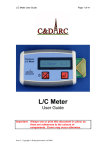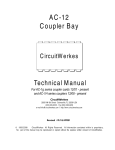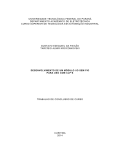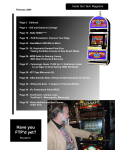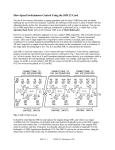Download Assembly Instructions
Transcript
RGB24 Strip Controller RGB DCSSR Feb 2015 RGB24 Board Version 1.00 DCSSR Board Version 1.00 Document Rev 2.10 Renard-Plus, Salem, Oregon 97302 © 2011-2015 Renard Plus. All rights reserved. Published 2015 Printed in United States Renard-Plus (“Developer”) has made every effort to ensure the accuracy of this document. Developer makes no warranties with respect to this documentation and disclaims any implied warranties of merchantability and fitness for a particular purpose. The information in this document is subject to change without notice. Developer assumes no responsibility for any errors that may appear in this document. The information contained herein is the exclusive and confidential property of Renard Plus, except as otherwise indicated. We wish to also thank the Do It Yourself Community for the inspiration it has given us in the development of this product. Trademarks the Renard Plus logo are trademarks of Renard Plus. All other trademarks acknowledged. Table of Contents TABLE OF CONTENTS .............................................................................................................................................2 1. INTRODUCTION TO RENARD .......................................................................................................................3 2. OVERVIEW OF RENARD PLUS RGB24 AND DCSSR .................................................................................4 3. ASSEMBLY INSTRUCTIONS..........................................................................................................................5 3.1 BOMS...........................................................................................................................................................5 3.1.1 RGB24 Parts List ...............................................................................................................................5 3.1.2 DCSSR Parts List ..............................................................................................................................6 3.2 CONTROLLER BOARD ASSEMBLY ....................................................................................................................7 3.2.1 First things first ..................................................................................................................................7 3.3 RGB24 ASSEMBLY GUIDE .............................................................................................................................8 3.3.1 Install the resistors and Diodes .........................................................................................................8 3.3.2 Install IC sockets ............................................................................................................................ 10 3.3.3 Install the capacitors ....................................................................................................................... 11 3.3.4 Install the light emitting diodes ....................................................................................................... 12 3.3.5 Install Misc. Parts ........................................................................................................................... 13 3.3.6 RGB24 Initial Testing / Final Assembly .......................................................................................... 15 3.3.7 Install the ICs: ................................................................................................................................. 16 3.4 DCSSR ASSEMBLY GUIDE.......................................................................................................................... 17 3.4.1 Install Parts Group 1 and 2............................................................................................................. 17 4. FINAL STEPS ............................................................................................................................................... 22 4.1 4.2 PROGRAMMING THE PIC ............................................................................................................................. 22 RGB24 JUMPER SETTINGS / HEADERS ........................................................................................................ 22 4.2.1 JP1 XBee Header ........................................................................................................................... 22 4.2.2 JP2 PIC Bypass ............................................................................................................................. 22 4.2.3 JP3 RS485 Terminator ................................................................................................................... 23 4.2.4 Programming- ICSP Header .......................................................................................................... 23 4.3 CONNECTING THE RENARD TO YOUR PC ...................................................................................................... 24 4.3.1 RJ45 Wiring .................................................................................................................................... 24 4.3.1 DMX wiring ..................................................................................................................................... 24 4.3.2 Computer Setup ............................................................................................................................. 25 4.4 FINAL TESTING ........................................................................................................................................... 25 4.4.1 Diagnostic LED Status Lights ......................................................................................................... 25 4.4.2 Test Procedure ............................................................................................................................... 25 5. PARTS PLACEMENT DIAGRAM ................................................................................................................. 26 5.1 5.2 6. RGB24 ...................................................................................................................................................... 26 DCSSR ..................................................................................................................................................... 27 NOTES .......................................................................................................................................................... 28 Renard Plus www.renard-plus.com Page 2 of 28 Renard Plus RGB24 Strip Controller V1.00 Renard Plus DCSSR V1.00 1. Introduction to Renard Renard is the name of a “do-it-yourself” (DIY), computer-controlled, PIC-based dimmer light control concept. It also refers to a family of dimming controllers that have been designed and built based on this concept. The Renard design concept was originally described by Phil Short in the Simple PIC-Based 8Port Dimmer 'How-To' on the http://computerchristmas.com website. Since then there have been many enhancements and new designs based on this hardware. There have been many contributors to advancing Renard technology including M. Macmillan, D. Davis, P. Rogers, T. Straub, D. Haberle, A. Williams and others Renard controllers typically rely on a separate computer running a light sequencing program to send it real-time sequences of controller commands to sequence the lights. The computer communicates with the Renard via RS232, RS485, or wireless (depending on the design) and the Renard controls the lights either through built-in power control (power is output directly to the lights), or via separate “SSRs” (solid state relays supply the power when commanded by the controller). Example Renard configurations Output of the Renard can be either control signals (to an SSR), direct AC line voltage (110, 100/220, or 220), or DC voltage depending on the design. Renard is a DIY hobbyist effort and there is a vast amount of products and related peripherals to select from including the Renard Plus Strip Controller. To obtain a specific design, there might be “buy a parts kit and/or blank PCB” offering at a site (such as from www.renardplus.com), “etch it yourself” files for true DIY, or coop/group buys for kits and PCBs also in forums (like DIYChristmas.org). Renard Plus www.renard-plus.com Page 3 of 28 Renard Plus RGB24 Strip Controller V1.00 Renard Plus DCSSR V1.00 2. Overview of Renard Plus RGB24 and DCSSR This guide covers the RGB24 and companion DCSSR. This combination is designed primarily to drive sets of red, green, and blue DC lights like LEDs or “low voltage” DC incandescent lights. The RGB24 is designed to drive an external solid state relay thus each of its RJ45 output connectors controls 3 channels of “RGB” SSRs such as the DCSSR which in turn will power 1 set of RGB lights for a total of 3 channels per DCSSR. The RGB24 will control up to 8 DCSSRs for a total channel count of 24 channels (8 sets of RGB DC). Feature Detail Name Renard Plus RGB24 Target use DC RGB Light control Channel Count 24 (8 sets of RGB) Power input 5-24v DC Power output No – controls SSR Dimmable? YES – PWM Status Indicators? YES Channel Indicators? NO Control Input – Renard YES – RS485 or optional wireless Control Input – DMX TBD Daisy-chain output YES – Renard RS485 pinout Wireless Option – w/add-on Xbee Snap-In board On board programming Yes through ICSP connector Feature Name Target use Channel Count Power input Power output Dimmable? Status Indicators? Channel Indicators? Control Input – Renard Daisy-chain output Renard Plus www.renard-plus.com Detail Renard Plus DCSSR Companion to RGB24 3 (1 set of RGB) 5-24v DC YES – DC YES – PWM YES NO YES – Renard SSR pinout NO Page 4 of 28 Renard Plus RGB24 Strip Controller V1.00 Renard Plus DCSSR V1.00 3. Assembly Instructions This section covers the construction of your Renard Plus Strip Controller RGB24 and DCSSRs. It approaches these tasks as a learning exercise for new builders, so that they can develop proficiency and self-confidence. The project itself is quite simple and if you follow the steps carefully, you should have a working controller when you are done. Additional information and guides on techniques and tools can be found at: www.renard-plus.com/files/Tool_Selection_Guide.pdf 3.1 BOMs 3.1.1 RGB24 Parts List The following is the Bill of Materials for the RGB24. This is the Mouser project link: http://www.mouser.com/ProjectManager/ProjectDetail.aspx?AccessID=70b8220d67 Picture Designators Description Qty Mouser P/N Renard Plus www.renard-plus.com R1, R2, R10 1k ohm resistor 1/4 watt 3 291-1k-RC R3, R4, R5 330 ohm resistor 1/4 watt 3 291-330-RC R6 R7 10K ohm resistor 1/4 watt 120 ohm resistor 1/4 watt 1 1 291-10K-RC 291-120-RC R11, R12 27k ohm resistor 1/4 watt 2 291-27k-RC D1 1N5239 (9.1v) zener diode 1 78-1N5239B D2 1N5229 (4.3v) zener diode 1 78-1N5229B C1, C3, C4, C5, C6 .1uf cap 5 81-RDER71H104K0K103B C2 220uf 25V Electrolytic Cap 1 647-UHE1V221MPD TB1 Tyco Terminal Block vertical 1 571-7969492 J1-J10 IC1 Modular Jacks 8 PCB TOP ENTRY IC & Component Sockets 40P IC2 10 571-5556416-1 1 517-4840-6000-CP or 649-DILB40P223TLF 8 pin IC socket (Optional) 1 517-4808-3004-CP IC3 6 pin IC Sockets (Optional) 1 571-1-390261-1 ICSP, JP1, JP2, JP3 16 pin header cut to fit: ICSP, JP1, JP2, JP3 1 571-16404526 Shunts for JP1, JP2 3 649-63429-202LF IC4 LM7805CT voltage regulator 1 512-LM7805CT IC2 65LBC179 1 595-SN65LBC179P IC3 H11AA1 1 782-H11AA1 IC1 PIC Microcontrollers (MCU) PIC18F4520 or 4620 and 4525 1 579-PIC18F4520-I/P Status yellow 5 MM LED 1 78-TLHY5405 Power, HB, ZC Red 5 MM LED 3 78-TLHR5401 RX Green 5 MM LED 1 78-TLHG5401 Page 5 of 28 Renard Plus RGB24 Strip Controller V1.00 Renard Plus DCSSR V1.00 3.1.2 DCSSR Parts List The following is the Bill of Materials one DCSSR. This is the Mouser project link: http://www.mouser.com/ProjectManager/ProjectDetail.aspx?AccessID=cab0aeb42e Picture Designators Description Qty Mouser P/N R1, R2, R3 680 ohm resistor 1 / 4 watt 3 291-680-RC R4, R5, R6 R7, R8, R9 R10, R11 C4 470 ohm resistor 1 / 4 watt 10K ohm resistor 1 / 4 watt 1k ohm resistor 1 / 4 watt 100uf 35V Electrolytic Cap 3 3 2 1 291-470-RC 291-10k-RC 291-1k-RC 647-UVR1V101MED1TA C1, C2, C3 .1uf cap 3 81-RDER71H104K0K103B DCIN, CH1, CH2, CH3 Tyco Terminal Block vertical 4 571-7969492 J2 Modular Jacks 8 PCB TOP ENTRY 1 571-5556416-1 IC2 16 pin IC socket (optional) 1 571-1-2199298-4 IC1* Low Current 5 volt voltage regulator* LM7805CT voltage regulator* 1 512-LM78L05ACZX* 1 512-LM7805CT* IC2 K847PH optocoupler 3 782-K847PH Q1, Q2, Q3 Power FET 3 512-FQPF13N06L Power Red 5 MM LED 3 78-TLHR5401 Online Green 5 MM LED 1 78-TLHG5401 F1 Fuse Holder 2 534-3517 F1 Fuse 10amp fast acting 1 504-GMA-10 IC3* * See assembly instructions. Use either IC1 or IC3: 5 volt regulator not both! Renard Plus www.renard-plus.com Page 6 of 28 Renard Plus RGB24 Strip Controller V1.00 Renard Plus DCSSR V1.00 3.2 Controller Board Assembly The Renard Plus RGB24 Strip Controller and DCSSR are simple devices to assemble and test. It is easiest if you build the units by inserting the various components from smallest to tallest. 3.2.1 First things first 1. Begin by inspecting the PCBs to look for any defects such as cracks or breaks. The holes on the board should be open on both sides. 2. Next inspect and sort out the various parts for the board. Make sure you understand which parts are which, and things like resistor codes and component orientation. A separate document on these concepts is available at www.renardplus.com/files/Tools_and_Parts_ID_Guide.pdf and on other resource sites like Wikipedia. 3. Follow the assembly guide as follows in the next section. Renard Plus www.renard-plus.com Page 7 of 28 Renard Plus RGB24 Strip Controller V1.00 Renard Plus DCSSR V1.00 3.3 RGB24 Assembly Guide 3.3.1 Install the resistors and Diodes Step Instructions Install 1K (brown-black-red) ohm 1 resistors at locations R1, R2, R10 Solder and clip the leads. 2 Install 330 (orange-orange-brown) ohm resistors at locations R3, R4, R5. Solder and clip the leads. 3 Install the 10K (brown-blackorange) ohm resistor at location R6. Solder and clip the leads. 4 Install the 120 (brown-red-brown) ohm resistor at location R7. Solder and clip the leads. Renard Plus www.renard-plus.com RGB24 Page 8 of 28 Renard Plus RGB24 Strip Controller V1.00 Renard Plus DCSSR V1.00 Step 5 6 7 Instructions Install 27K (red-violet-orange) ohm resistors at locations R11,R12. Solder and clip the leads. RGB24 Install the 1N5239 diode at location D1. The diode is polarized and only works one way. The end with the band (cathode) goes towards the RIGHT side of the board (with your board oriented as shown) just as the silkscreen indicates. Solder and clip the leads. Install the 1N5229 diode at location D2. The diode is polarized and it can only go one way. The end with the band (cathode) goes towards the RIGHT side of the board. Solder and clip the leads Renard Plus www.renard-plus.com Page 9 of 28 Renard Plus RGB24 Strip Controller V1.00 Renard Plus DCSSR V1.00 3.3.2 Install IC sockets Even though these parts are optional we strongly recommend that sockets be used on all of the IC’s. Note: If you are not installing sockets, it is recommended you wait to install the ICs until AFTER you test power. Please see “Installing ICs” section later in this chapter. Pin 1 of the IC socket aligns to the square solder pad on the PCB. Also, if the socket has a notch at one end, that will align with the notch on the silkscreen for the IC location on the board. See diagram below. Step 8 9 Instructions Install the 8 pin socket at location IC1. Make sure the notched or dimpled end is lined up with the notched end of the silk screen board outline. The notch on the socket should face the right side of the board. Solder one pin and make sure the socket is firmly seated before continuing to solder the remaining pins. Solder all pins. RGB24 Pin 1 of the IC socket is on the end, closest to the notch. Install the 40 pin socket at location IC2. Make sure the notched or dimpled end is lined up with the notched end of the silk screen board outline. The notch on the socket should face the right side of the board. Solder one pin and make sure the socket is firmly seated before continuing to solder the remaining pins. Solder all pins. Renard Plus www.renard-plus.com Page 10 of 28 Renard Plus RGB24 Strip Controller V1.00 Renard Plus DCSSR V1.00 3.3.3 Install the capacitors Some capacitors, like ceramic caps used for signal noise suppression, do not have a polarity and can be installed in either orientation. Other caps, like electrolytic or tantalum caps used for voltage filtering and power droop suppression typically DO have an orientation and need to be installed carefully. Look for a stripe (white or black depending on the cap color), arrows, or polarity indicators (typically negative signs “-“) indicating the polarity of the part. This board uses both ceramic and electrolytic so please follow the installation instructions carefully. Step 10 Instructions Install 0.1uf Ceramic Capacitors (marked 104) at locations C1, C3, C4, C5, C6. Solder and clip the leads. RGB24 Note these parts are NOT polarized. 11 Install the 220uf Electrolytic Capacitor at location C2 which is polarized. Be sure that the (+) lead is installed in the hole marked with a “+” symbol. The (+) lead is usually longer than the (-) lead, and the (-) lead is typically identified by a black or white stripe or negative signs printed on the capacitor. Solder and clip the leads. Renard Plus www.renard-plus.com Page 11 of 28 Renard Plus RGB24 Strip Controller V1.00 Renard Plus DCSSR V1.00 3.3.4 Install the light emitting diodes LED’s (light emitting diodes) must be installed according to the silk screen pattern on the board. In looking at an LED you will notice a flat spot on one side of the LED which indicates the cathode or negative leg of the LED. Step Instructions RGB24 Install the Red LEDs at the locations marked Power, HB, ZC. The LED is polarized. There is a flat side (cathode) that has a short lead and it faces towards the right side of the board. Solder and clip the leads. 12 13 Install the Yellow LED at the location marked FE. The LED is polarized. There is a flat side (cathode) that has a short lead and it faces towards the right side of the board. Solder and clip the leads. 14 Install the Green LED at the location marked RX. The LED is polarized. There is a flat side (cathode) that has a short lead and it faces towards the right side of the board. Solder and clip the leads. Renard Plus www.renard-plus.com Page 12 of 28 Renard Plus RGB24 Strip Controller V1.00 Renard Plus DCSSR V1.00 3.3.5 Install Misc. Parts You may have purchased either a single 16 pin header or headers cut according to the board specifications. When installing headers the short side of the header is installed into the board. Step 15 Instructions Install the 5 pin header at location JP1 (RENW header). Solder 16 Install the 3 pin header at location JP2 (PIC bypass). Solder. 17 Install the 2 pin header at location JP3 (RS485 Term). Solder. 18 Install the 6 pin header at location ICSP (PIC programming header). Solder. Renard Plus www.renard-plus.com RGB24 Page 13 of 28 Renard Plus RGB24 Strip Controller V1.00 Renard Plus DCSSR V1.00 Step Instructions 19a 7-24DC input option 19b 5V Only Option 20 21 RGB24 If the input voltage to the board on TB1 will be 7 to 24vDC please use this option. Install the 5v linear regulator at location IC3 forming the leads as indicated below. Fold the pins over the shaft of a small screwdriver to create smooth bends. Apply a layer of heat sink compound to the back of the regulator. After inserting the leads into the proper holes, secure the IC with a 4-40 bolt, #4 lock washer, and a 4-40 nut. Solder --OR -If your DC voltage input on TB1 will be a well regulated 5V DC, then follow this option. Omit the voltage regulator at IC3. Form a jumper to loop from IC3 pin 1 to pin 3 from a cut-off resistor or capacitor leg. Besure the jumper does NOT contact the center pin or any other components. Solder. Install the RJ45 jacks at locations J1-10. Gently align the eight wires with the matching holes and snap the connector to the board. Solder. Install the 2 position terminal strip location TB1. The side where the wires enter under the screw should face the top of the board. Note: This is where you will apply power for the controller board. 22 Install the shunts on the headers according to the Jumper Settings / Header Settings section in a following chapter. Renard Plus www.renard-plus.com Page 14 of 28 Renard Plus RGB24 Strip Controller V1.00 Renard Plus DCSSR V1.00 3.3.6 RGB24 Initial Testing / Final Assembly At this point you have completed the assembly of the board and you should gently clean the board of any residue and inspect for solder bridges. What you are looking for are any solder bridges especially around the IC’s and other closely spaced parts. Connect your 5-24vdc power supply to the TB1 terminal strip noting the polarity V+ and V-. It supplies power to the controller portion of the board. Turn on your power supply and verify the power LED lights up. Using a DMM, verify you have 5v DC (4.85 to 5.15 or so) between pins 1 and 4 on the 485 chip socket as well as between pins 11 and 12 on the PIC socket. If the voltage does NOT measure near +5, remove power and start troubleshooting. Look for solder bridges around the regulator, or around the TB1. Double check the regulator number to make sure it is what you expect (something like LM7805 or LM340T-5). Verify the input power supply is DC between 7v and 24v DC (measure at TB1). If you are inputting 5V DC, be sure you did NOT install the regulator but instead followed the “5V Only” option in the assembly instructions. If power is good, turn off your power supply and continue assembling. Renard Plus www.renard-plus.com Page 15 of 28 Renard Plus RGB24 Strip Controller V1.00 Renard Plus DCSSR V1.00 3.3.7 Install the ICs: After verifying the voltage, it is now safe to install the IC’s. You should handle them carefully, and avoid static electricity or other rough handling. Try to avoid bending pins when inserting them in the sockets. You might want to slightly straighten the IC legs by placing the side of the IC against a flat surface and lightly bending them inward and straighter up and down than they typically are shipped from the manufacturer. Step 23 24 Instructions RGB24 Install the PIC18F4520 in the 40 pin socket at location IC2. The IC is polarized. Gently install the IC so that the notch faces towards the right matching the socket and the silkscreen. Install the SN65LBC179P in the 8 pin socket at location IC1. The IC is polarized. Gently install the IC so that the notch faces towards the right matching the socket and the silkscreen. Renard Plus www.renard-plus.com Page 16 of 28 Renard Plus RGB24 Strip Controller V1.00 Renard Plus DCSSR V1.00 3.4 DCSSR Assembly Guide 3.4.1 Install Parts Group 1 and 2 Step 1 2 3 Instructions Install 680 (blue-gray-brown) ohm resistors at locations R1, R2, R3. Solder and clip the leads. DCSSR Install 470 (yellow-violet-brown) ohm resistors at locations R4, R5, R6. Solder and clip the leads. Install 10K (brown-black-orange) ohm resistors at locations R7, R8, R9. Solder and clip the leads. Renard Plus www.renard-plus.com Page 17 of 28 Renard Plus RGB24 Strip Controller V1.00 Renard Plus DCSSR V1.00 Step 4 5 Instructions Install 1K (brown-black-red) ohm resistors at locations R10, R11. Solder and clip the leads. DCSSR Install 0.1uf Ceramic Capacitors (marked 104) at locations C1, C3, C4. Solder and clip the leads. Note: These parts do NOT have a specific orientation. 6 Install the 100uf Electrolytic Capacitor at location C4 which is polarized. Be sure that the (+) lead is installed in the hole marked with a “+” symbol. The (+) lead is usually longer than the (-) lead, and the (-) lead is typically identified by a black or white stripe and/or negative signs printed on the capacitor. Solder and clip the leads. 7 Install the 16 pin socket at location IC2. (see instructions) Make sure the notched or dimpled end is lined up with the notched end of the silk screen board outline. The notch on the socket should face the right side of the board. Solder one pin and make sure the socket is firmly seated before continuing to solder the remaining pins. Solder all pins. Pin 1 of the IC socket is on the end, closest to the notch. 8 Install the Red LED at the location marked Power. The LED is polarized. There is a flat side (cathode) that has a short lead and it faces towards the right side of the board. Solder and clip the leads. Renard Plus www.renard-plus.com Page 18 of 28 Renard Plus RGB24 Strip Controller V1.00 Renard Plus DCSSR V1.00 Step 9 10 Instructions Install the Green LED at the location marked Online. The LED is polarized. There is a flat side (cathode) that has a short lead and it faces towards the right side of the board. Solder and clip the leads. DCSSR Install fuse holder at location F1. The clips have dimples on one side of then and these must be facing towards the sides of the board and not the center. Solder. Install the fuse into the fuse holder. The fuse does not get soldered. Note: The fuses can be used to align the fuse clips for soldering as long as you do not overheat them. 11 Install the RJ45 jack at locations J2. Gently align the eight wires with the matching holes and snap the connector to the board. Solder all pins. 12 Install 4 terminal blocks at locations CH3, CH2, CH1, and DCIN. Before installing in board the 4 terminal blocks must be locked together. Note: The terminal blocks must be oriented facing outward. Renard Plus www.renard-plus.com Page 19 of 28 Renard Plus RGB24 Strip Controller V1.00 Renard Plus DCSSR V1.00 Step 13 Instructions DCSSR Install the K847PH optocoupler into socket at location IC2. The IC is polarized. Gently install the IC so that the notch lines up with notch in the 16 pin socket. Low Current Option The DCSSR may either built for low current or high current strips. Select either this option or the next but NOT BOTH! For Low Current option - Install LM78L05 (low current) at location IC1. The LM78L05 is installed with the flat side if the IC toward the side of the board. Solder and clip leads. 14b High Current Option For High Current option - Install LM7805CT at location IC3. The LM7805 is installed with the tab side toward the side of the board. Solder and clip leads. 14c For 5V Operation – If you will be applying ONLY 5v in to the board on the DCIN connector, you can omit both voltage regulators at IC1 and IC3 and place a jumper across IC1 as shown. 14a 5V Only Option 15 Note: With this option ONLY apply 5V DC to DCIN! Other voltages are very likely to cause damage. Install the FQPF13N06L power FETs at location Q1, Q2, Q3. The FETs should be installed with the tabs facing the terminal blocks. Solder and clip the leads. Renard Plus www.renard-plus.com Page 20 of 28 Renard Plus RGB24 Strip Controller V1.00 Renard Plus DCSSR V1.00 Renard Plus www.renard-plus.com Page 21 of 28 Renard Plus RGB24 Strip Controller V1.00 Renard Plus DCSSR V1.00 4. Final Steps At this point you will have now completed the installation of all of the parts to the controllers. Again, it is a good idea to visually inspect the board and check to make sure there are no solder bridges between the solder pads, and that the solder joints are all a good quality. 4.1 Programming the PIC Note: The Renard Plus LCC16 does not use the default Renard firmware used on other Renard devices. Make sure you use the Renard Plus version of the code! Programming the PIC can be done with the PIC chip plugged into a PIC programmer such as the PICStart from MicroChip or onboard using a programmer like a PicketIII or PicKit2. Programming PIC’s using standard assembly is written up in our PIC Programming Manual available on www.renard-plus.com. 4.2 RGB24 Jumper Settings / Headers 4.2.1 JP1 XBee Header This header can be used to connect a XBee Wireless module directly to the Renard Plus Strip using a Xbee Snap-in board or indirectly using 3 wires to a board such as the REN-W. If you are not using XBee Wireless then you must jumper pins 4/5 using a shunt jumper. The following are the pinouts for the Xbee header: Pin Layout 1 = +5VDC 2 = N/C 3 = GND 4 = RX from 485 chip 5 = RX in to PIC Option - Xbee using Snapin Board Note: When assembling the DIGWDF Xbee SnapIn board (http://diychristmas.org/store/) install the female 5 pin header block on the bottom side of the board. Once assembled the SnapIn board can only be plugged in one direction. 4.2.2 JP2 PIC Bypass If you are using Start Address Programming, you can use the PIC bypass to allow the data to flow thru the Renard Plus Strip without the usual Renard "address eating". If you use a jumper across pins 1/2 then the data stream that comes into the device goes out exactly as it came in with no addresses consumed by the Renard Plus board. The default position is a jumper across pins 2/3. Pin Layout 1 = Data In From RS485 IC 2 = Data Out to RS485 IC 3 = Data Out from PIC Renard Plus www.renard-plus.com Page 22 of 28 Renard Plus RGB24 Strip Controller V1.00 Renard Plus DCSSR V1.00 4.2.3 JP3 RS485 Terminator There are situations where the communications from the computer might require termination. Usually line reflections or other environmental conditions can disrupt communications to the controller. You might see missed light transitions, jumpy animation, or complete no operation. In this case, adding termination *may* return reliable communications assuming everything else is working right. This jumper is usually only applies to the LAST board on a board to board chain of connections. 4.2.4 Programming- ICSP Header This header allows the PIC to be programmed while the PIC is installed on the board Pin Layout Pin 1 = MCLR Pin 2 = +5 volts Pin 3 = GND Pin 4 = PGD Pin 5 = PGC Pin 6 = PGM/RB5 Renard Plus www.renard-plus.com Page 23 of 28 Renard Plus RGB24 Strip Controller V1.00 Renard Plus DCSSR V1.00 4.3 Connecting the Renard to your PC This board has 2 RJ45 connectors that are used to receive data and pass data to the next controller. J1 RX J2 TX RS485 incoming data from either a RS485 converter or another controller RS485 outgoing data to next controller There are many options to connect your computer to the Renard Plus RGB24. Pictured here is a Hexim HXSP-2018F USB to RS485 adapter. When selecting an adapter look for ones that have an easy to use screw terminal like this one. 4.3.1 RJ45 Wiring A standard RJ45 networking cable can be used to connect the Renard to: 1. Your PC Serial RS485 adapter, 2. another Renard for daisy chain operation or, 3. SSRs if your board requires the use of SSRs (like this board). The cable must be a straight thru style and NOT a cross-over type cable. Just check and make sure that the pins on one end of the cable connect to the same pin on the other end of the cable (the wire colors in the connector are a way to tell- look for the same color pattern on both connectors). This is an example of a data cable wired to the EIA-568B standard. There are eight pins, numbered from left to right, EIA-568B RJ45 Socket looking at the jack. 4.3.1 DMX wiring If you are using Renard Plus DMX firmware on your board, and will be using a “standard” DMX source, you may need to create a special interconnect cable, or adapter to get the DMX data into the correct pins on your Renard Plus. DMX adapters with an RJ45 output typically have data on pins 1(data+) & 2(data1) with GND on 7 or 8 of the connector, and Renards have data on pins 4 (data-) & 5(data+) with GND on pins 1 & 2. DMX configurations will vary so check carefully! Renard Plus www.renard-plus.com Page 24 of 28 Signal Data + Data GND GND Renard RJ45 5 4 1 2 DMX RJ45 1 2 8 7 Renard Plus RGB24 Strip Controller V1.00 Renard Plus DCSSR V1.00 4.3.2 Computer Setup If you are using the Vixen sequencing software to drive your Renard Plus, it will require either one of the following plugins: • Renard Dimmer [Vixen 1.1.*] • Renard Dimmer (modified) [Vixen 2.*] If you are using Xbee wireless, the baud rate must be 57600. Suggested Renard Plug-In Settings 4.4 Final Testing The Renard Plus Strip Controller has 5 diagnostic LED status lights which are used as follows. 4.4.1 Diagnostic LED Status Lights For normal operation you should have the power LED lighted, ZC led PWR active and the status LED blinking every few seconds (the PIC must be programmed). If you are running a sequence, you should see the FE led OFF, and the RX LED flashing. ZC Power - Will be on when power is applied. ZC – “Zero Cross” Will be on when the AC “zero cross” is detected. RX – “Receive” Active when a sequence is running. 4.4.2 Test Procedure The data wiring of the Renard Plus RX Strip Controller is the same as other HB – “Heart Beat” Blinks every Renard boards. Standard nonfew seconds to indicate the crossover CAT5 network cables can HB microprocessor is active. be used to connect to SSRs, other FE – “Framing Error” will light if controllers, and/or the PC. Connect the serial communication is FE your Renard Plus to your PC using incorrect. Typically this a standard CAT5 cable from the indicates a mismatch between the baud rate in the PIC controller RX jack to a RS485 firmware and the baud rate connection on your PC. Attach a setting on the PC for the RS485 SSR and one set of dimmable adapter. lights. Program a Vixen sequence to turn on/off each of the channels on the controller and run it. We would suggest that each channel is turned on for 4 or 5 seconds. Observe that the connected channel responds as programmed. Next, do a full load test by attaching the rest of the SSRs and lights and observe all lights are being controlled. Next, change the sequence from on/off to slow ramp up/downs to verify dimming. Congratulations, with a successful test, you have completed your build of your Renard Plus controller and are ready for the wonderful world of light animation sequencing! Renard Plus www.renard-plus.com Page 25 of 28 Renard Plus RGB24 Strip Controller V1.00 Renard Plus DCSSR V1.00 5. Parts Placement Diagram 5.1 RGB24 Renard Plus www.renard-plus.com Page 26 of 28 Renard Plus RGB24 Strip Controller V1.00 Renard Plus DCSSR V1.00 5.2 DCSSR Renard Plus www.renard-plus.com Page 27 of 28 Renard Plus RGB24 Strip Controller V1.00 Renard Plus DCSSR V1.00 6. Notes Use this page for notes about the boards. Renard Plus www.renard-plus.com Page 28 of 28 Renard Plus RGB24 Strip Controller V1.00 Renard Plus DCSSR V1.00





























